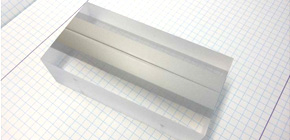
Two-dimensional 100-nm focusing achieved using high accuracy ellipsoidal mirror at Spring-8
Focus size previously requiring two mirrors achieved with single mirror
Japan Synchrotron Radiation Research Institute, Osaka University, and RIKEN fabricated an ellipsoidal mirror for two-dimensional 100-nm focusing with a nanoscale surface-figure accuracy, the best result achieved using ellipsoidal mirrors, at the large synchrotron radiation facility SPring-8.
At SPring-8 and SACLA (SPring-8 Angstrom Compact Free Electron Laser), X-ray microscopes for sensitive analysis and trace element analysis, in which microsamples are illuminated with X-ray beams from a light source in order to efficiently detect signals from the samples, are highly necessary.
Thus, it is necessary to sophisticate techniques to create X-ray focusing optics, i.e., lenses to generate X-ray beams. Conventionally, two X-ray mirrors were combined to generate two-dimensional focusing beams and it was impossible to fabricate x-ray mirrors capable of generating two-dimensional focusing beams with a single x-ray mirror.
This group succeeded in developing mirrors with an elliptical surface that can generate two-dimensional focusing beams with a single x-ray mirror. High precision is required for processing the highly sloped surface of ellipsoidal X-ray mirrors that can generate two-dimensional nanofocusing beams; however, with conventional techniques, it was difficult to fabricate the two-dimensional aspherical surface of ellipsoidal mirrors with nanometer accuracy.
Resolving challenges in X-ray mirror producing techniques, such as aspheric machining and surface profile measurements, this group fabricated an ellipsoidal mirror with a surface-figure accuracy of 1 nm. They developed an X-ray microscope at SPring-8 using this ellipsoidal mirror and succeeded in generating a two-dimensional focusing beam of 125 nm in the vertical direction and 85 nm in the horizontal direction, achieving the world’s smallest focus size obtained using an ellipsoidal mirror. This demonstrated the validity of the technique for fabricating X-ray mirrors with a two-dimensional aspherical surface.
X-ray focusing using an ellipsoidal mirror will be useful in generating high-efficiency nanobeams and improving the stability of optic systems, which support a variety of advanced X-ray microscopes used at SPring-8 and SACLA.
Abstract
Cutting-edge hard X-ray microscopy strongly depends on sophisticated focusing optics and ultrabright X-ray sources at synchrotron-radiation and X-ray free-electron laser (XFEL) facilities. These facilities typically provide two-dimensional nanofocusing X-ray beams by combining one-dimensional focusing mirrors. However, single-reflecting two-dimensional focusing mirrors with an ellipsoidal surface, which are well-known to possess high efficiency, have limited microfocusing applications. In this paper, we present an ultrahigh-precision ellipsoidal mirror for two-dimensional X-ray nanofocusing by overcoming the difficulties faced in the manufacturing process of its aspherical surface, including the surface-processing methods and surface metrology. The developed mirror has nanoscale accuracy, and it achieves focus size of 85 nm × 125 nm (full width at half maximum) using 7-keV X-rays. Two-dimensional focus was demonstrated in the same focal plane by resolving 50-nm test structures by scanning X-ray microscopy using a focusing beam. These achievements represent an important first step toward realizing two-dimensional aspherical mirrors with complex designs, in addition to ultralow loss and unprecedented small focusing property for extensive optical applications in synchrotron-radiation and XFEL facilities as well as in other scientific fields that require ultraprecision optical surfaces.

Figure 1 . Optical layout for two-dimensional focusing with two reflective mirrors.
Each mirror has a one-dimensionally curved surface with an elliptical-cylinder shape to focus X-rays one-dimensionally. X-rays are focused two-dimensionally after two reflections. This optical layout is called the K‒B(Kirkpatrick‒Baez) mirrors arrangement.

Figure 2. Optical layout for two-dimensional focusing with a single reflective mirror.
This mirror has a two-dimensionally curved surface with an ellipsoidal shape. Ellipsoidal mirrors can focus X-rays two-dimensionally with a single reflection. X-rays are reflected under grazing-incidence angle conditions.
Figure 3. Photograph of developed ellipsoidal focusing mirror.
An ellipsoidal shape is formed on a glass (synthetic fused silica) substrate surface with dimensions of 100 mm × 50 mm × 30 mm. The surface was coated with a platinum film to obtain high reflectivity in the hard X-ray regions. The mirror surface was manufactured with a precision of 1 nanometer.

Figure 4. Measured intensity distribution of X-ray focusing beam formed by developed ellipsoidal mirror.
X-rays were two-dimensionally focused with a beam size of 125 nm (vertical) × 85 nm (horizontal), which shows the world's smallest beam size focused by ellipsoidal mirrors.
To learn more about this research, please view the full research report entitled " Ellipsoidal mirror for two-dimensional 100-nm focusing in hard X-ray region " at this page of Scientific Reports .
Related links
